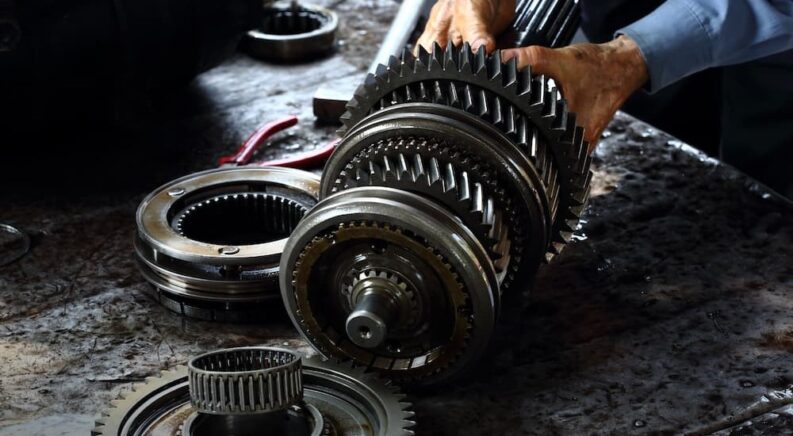While many drivers enjoy the convenience of an automatic transmission, some will tell you that there’s no substitute for a manual transmission. From fuel savings and lower repair costs to the sense of control and pure thrills they can provide, there are certainly a number of advantages that come with rowing your own gears. Maintenance costs are another important factor to consider. Given their relatively simple design––at least when compared to an automatic transmission––a manual transmission is often much cheaper to keep on the road.
That said, they’re not totally maintenance-free. While a manual might mean the trips to your local transmission shop are few and far between, there are some tips and best practices a driver should keep in mind if they want to enjoy consistent performance and longevity. Manual transmission maintenance can be broken down into two categories: actual maintenance tasks that need to be performed at regular intervals and good driving habits that will keep your ride out of the shop as much as possible. We’ll explore both of these categories in detail as we give you the goods on the manual gearbox.
Transmission Maintenance Tasks
Check and Replace Fluid
A manual transmission relies on a specialized fluid to help keep everything running smoothly. Manual transmission fluid serves three main roles: lubricating, cooling, and cleaning. This fluid lubricates the gears, shafts, and bearings, sparing them from the worst effects of the friction and heat generation present in any transmission system. The fluid dissipates this heat, cooling the transmission while also serving to clean the sensitive parts by flushing out any dirt, metal shavings, or contaminates that might find their way in.
In a perfectly enclosed system free of any leaks, transmission fluid should never drop over time, but it will start to break down and lose its effectiveness due to heat and oxidation. These factors can cause transmission fluid to become less viscous, preventing it from efficiently cooling and lubricating transmission components. Transmission fluid has also been known to absorb moisture, leading to corrosion that could wreak havoc on the transmission. The effect is especially noticeable in vehicles that are exposed to a lot of wet or humid weather, so take extra care if you regularly operate in such climates.
How can a driver avoid these worst-case scenarios? It all comes down to regular fluid checks and flushes. A manual transmission’s fluid can be easily checked using the dipstick, but regardless of how good of a reading you get, you should always pencil in a transmission fluid flush on a regular schedule as recommended by the manufacturer. A transmission fluid flush is a small investment when you consider the potential consequences of letting it fall by the wayside.

Get a Transmission Inspection
While a manual transmission will often be subjected to a thorough inspection during a typical flush and refill, those taking the DIY route should still make sure to have a professional give the transmission a once-over every so often. Most experts recommend having this service performed every year, but it all depends on how much use the vehicle is getting. If you’re using your manual transmission vehicle as a daily driver, an annual check-up is well within the ballpark. If your manual vehicle is typically reserved for Sunday drivers or only used in the warmer months, you might be able to go a few years between inspections.
Change Transmission Filter
Automakers have phased out transmission fluid filters in most modern manuals, but if your ride is of a certain vintage, this could be an important part of your regular maintenance routine. The exact schedule depends only on the specific make and model, but if you have a filter, you will want to replace it regularly. Some drivers like to perform a filter change every time the transmission fluid is flushed and replaced, but if you’re unsure, check the owner’s manual for further details.
Transmission Care Habits
Learn Proper Shifting
Shifting a manual transmission is no small task and is often one of the biggest hurdles a new driver faces when switching from an automatic to a manual. Proper shifting technique involves letting off the gas pedal and fully depressing the clutch before attempting to shift into a new gear. It sounds simple, but it often takes a lot of practice. Failing to shift correctly can result in all sorts of unpleasant noises and sensations, stalling the engine, and even stripped gears.
Don’t Money Shift
Missing a gear can turn into an expensive habit if you don’t know your way around a manual transmission. This is often known as “money shifting” due to the cash it could cost you to repair a damaged transmission and should obviously be avoided at all costs. The more you drive your manual transmission vehicle, the more familiar you’ll become with the shifting routine, but when you’re just starting out, it’s easy to get flustered and skip over gears, wearing down the clutch and creating a dangerous––and expensive––situation.
Use the Right Gears
An automatic transmission takes all the guesswork out of the shifting process. While this results in a hassle-free driving experience, it also robs drivers of some control and can prevent them from feeling like they’re forging a real connection with the vehicle. A manual transmission leaves the choice of gear up to the driver, but it’s important to choose wisely. Remember to always shift to a higher gear before hitting the redline and avoid high RPMs whenever possible. Your typical tachometer will usually run to 8,000 RPM, but most experts advise shifting to a higher gear no later than the 4,000 RPM mark. If you’re looking to maximize fuel efficiency, shifting at 2,000 to 3,000 RPM can save you some gas at the cost of achieving full power.

Come To a Full Stop
This tip isn’t unique to a manual transmission, but it’s certainly worth mentioning. When trying to move backward, drivers should ensure they come to a complete stop before shifting into reverse. Shifting too abruptly can easily strip the gears and lead to a costly repair, so take a moment before putting it in R.
Avoid Riding the Clutch
Keeping your foot on the clutch while driving can be a hard habit for some new manual drivers to break, but it’s an important part of the learning curve. Known as riding the clutch, this habit can cause the clutch to slip and wear out. Remember: the clutch pedal is not a good place to rest your foot and should only be engaged when you’re actively shifting. This is just as important when you’re stopped as when you’re speeding down the road. Shifting into neutral and removing your foot from the clutch when at a stop sign or traffic light can lessen the wear on your transmission.
Hands Off the Shift Knob
The shift knob looks like a comfy, ergonomic place to rest your hand, but it’s really for shifting and shifting only. Letting your hand rest on the shift knob while driving, even lightly, can cause premature wear in the transmission forks and collar. Over time, this could lead to the type of inaccurate, messy shifts that can open the door to missed gears.
Learn Your Car’s Needs
A manual transmission offers a number of advantages over the more popular automatic. While a vehicle with a manual transmission is often cheaper to buy, maintain, and repair than a similar automatic model, there are a few important tasks and habits that should never be neglected. We’ve outlined some of the basic maintenance tasks and when they should be performed, but when in doubt, consult your owner’s manual. Each vehicle has slightly different needs when it comes to regular maintenance, which is exactly why automakers invest time in producing these thick tomes. Developing good shifting habits can pay dividends when it comes to wear and tear on the clutch, though you’re bound to experience a few missteps before discovering your inner Dale Jr. Take each blunder as a learning experience, and you’ll be shifting your manual transmission with the best of them in no time.

